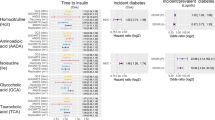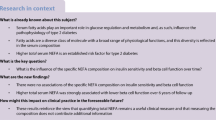Abstract
Aims
Recent studies in mouse models of T2D showed that interleukin-6 (IL-6), released from skeletal muscle, is associated with increased glucose-dependent insulin secretion. Few data currently exist exploring the relationship between IL-6 and beta-cell function in humans. We investigated whether IL-6 is positively associated with beta-cell function in newly diagnosed T2D. We extended the same analyses to IL-10, because it regulated similarly to IL-6 in skeletal muscle, and TNF-α and C-reactive protein (CRP), as general biomarkers of inflammation.
Methods
In 330 VNDS participants, we assessed (1) basal plasma concentrations of IL-6, IL-10, TNF-α, and CRP; (2) beta-cell function, estimated by OGTT minimal modeling and expressed as derivative (DC) and proportional control (PC); (3) insulin sensitivity, by euglycemic insulin clamp.
Results
IL-6 was positively associated with PC in both univariate analysis (p = 0.04) and after adjustment for age, sex, BMI, HbA1c, and M-clamp (p = 0.01). HbA1c was the major independent contributor to the overall variance of PC (16 %), followed by BMI and IL-6 (~2 % each). Similar results were obtained for IL-10 (p = 0.048, univariate; p = 0.04, fully adjusted). TNF-α and CRP were not significantly associated with any component of beta-cell function.
Conclusions
Our data are the first evidence in human subjects that an endocrine loop involving IL-6 may act as positive modulator of glucose-dependent insulin secretion. Further functional studies are needed to corroborate IL-6 system as a potential druggable target in diabetes.
Clinical trial registration number
NCT01526720 (http://www.clinicaltrial.gov).

Similar content being viewed by others
Abbreviations
- VNDS:
-
Verona Newly Diagnosed Type 2 Diabetes Study
- IL-6:
-
Interleukin-6
- IL-10:
-
Interleukin-10
- TNF-α:
-
Tumor necrosis factor-alpha
- hsCRP:
-
High-sensitivity C-reactive protein
- GLP-1:
-
Glucagon-like peptide-1
References
Accili D (2004) Lilly lecture 2003: the struggle for mastery in insulin action: from triumvirate to republic. Diabetes 53(7):1633–1642
Odegaard JI, Chawla A (2013) Pleiotropic actions of insulin resistance and inflammation in metabolic homeostasis. Science 339(6116):172–177
Ceriello A, Motz E (2004) Is oxidative stress the pathogenic mechanism underlying insulin resistance, diabetes, and cardiovascular disease? the common soil hypothesis revisited. Arterioscler Thromb Vasc Biol 24(5):816–823
Bensellam M, Laybutt DR, Jonas JC (2012) The molecular mechanisms of pancreatic beta-cell glucotoxicity: recent findings and future research directions. Mol Cell Endocrinol 364(1–2):1–27
Freeman DJ, Norrie J, Caslake MJ et al (2002) West of Scotland Coronary Prevention S: C-reactive protein is an independent predictor of risk for the development of diabetes in the West of Scotland Coronary Prevention Study. Diabetes 51(5):1596–1600
Scheller J, Rose-John S (2012) The interleukin 6 pathway and atherosclerosis. Lancet 380(9839):338
Mohamed-Ali V, Goodrick S, Rawesh A et al (1997) Subcutaneous adipose tissue releases interleukin-6, but not tumor necrosis factor-alpha, in vivo. J Clin Endocrinol Metab 82(12):4196–4200
Mohamed-Ali V, Goodrick S, Bulmer K, Holly JM, Yudkin JS, Coppack SW (1999) Production of soluble tumor necrosis factor receptors by human subcutaneous adipose tissue in vivo. Am J Physiol 277(6 Pt 1):E971–E975
Steensberg A, van Hall G, Osada T, Sacchetti M, Saltin B (2000) Klarlund Pedersen B: Production of interleukin-6 in contracting human skeletal muscles can account for the exercise-induced increase in plasma interleukin-6. J Physiol 529(Pt 1):237–242
Febbraio MA, Ott P, Nielsen HB et al (2003) Hepatosplanchnic clearance of interleukin-6 in humans during exercise. Am J Physiol Endocrinol Metab 285(2):E397–E402
Peake JM, Della Gatta P, Suzuki K, Nieman DC (2015) Cytokine expression and secretion by skeletal muscle cells: regulatory mechanisms and exercise effects. Exerc Immunol Rev 21:8–25
Steensberg A, Keller C, Starkie RL, Osada T, Febbraio MA, Pedersen BK (2002) IL-6 and TNF-alpha expression in, and release from, contracting human skeletal muscle. Am J Physiol Endocrinol Metab 283(6):E1272–E1278
van Hall G, Steensberg A, Fischer C et al (2008) Interleukin-6 markedly decreases skeletal muscle protein turnover and increases nonmuscle amino acid utilization in healthy individuals. J Clin Endocrinol Metab 93(7):2851–2858
Perry RJ, Camporez JP, Kursawe R et al (2015) Hepatic acetyl CoA links adipose tissue inflammation to hepatic insulin resistance and type 2 diabetes. Cell 160(4):745–758
Glund S, Deshmukh A, Long YC et al (2007) Interleukin-6 directly increases glucose metabolism in resting human skeletal muscle. Diabetes 56(6):1630–1637
Steensberg A, Fischer CP, Sacchetti M et al (2003) Acute interleukin-6 administration does not impair muscle glucose uptake or whole-body glucose disposal in healthy humans. J Physiol 548(Pt 2):631–638
Fosgerau K, Galle P, Hansen T et al (2010) Interleukin-6 autoantibodies are involved in the pathogenesis of a subset of type 2 diabetes. J Endocrinol 204(3):265–273
Halban PA, Polonsky KS, Bowden DW et al (2014) Beta-cell failure in type 2 diabetes: postulated mechanisms and prospects for prevention and treatment. Diabetes Care 37(6):1751–1758
Shimizu H, Ohtani K, Kato Y, Mori M (2000) Interleukin-6 increases insulin secretion and preproinsulin mRNA expression via Ca2+-dependent mechanism. J Endocrinol 166(1):121–126
Suzuki T, Imai J, Yamada T et al (2011) Interleukin-6 enhances glucose-stimulated insulin secretion from pancreatic beta-cells: potential involvement of the PLC-IP3-dependent pathway. Diabetes 60(2):537–547
Ellingsgaard H, Ehses JA, Hammar EB et al (2008) Interleukin-6 regulates pancreatic alpha-cell mass expansion. Proc Natl Acad Sci USA 105(35):13163–13168
Vozarova B, Weyer C, Hanson K, Tataranni PA, Bogardus C, Pratley RE (2001) Circulating interleukin-6 in relation to adiposity, insulin action, and insulin secretion. Obes Res 9(7):414–417
Kumar H, Mishra M, Bajpai S et al (2013) Correlation of insulin resistance, beta cell function and insulin sensitivity with serum sFas and sFasL in newly diagnosed type 2 diabetes. Acta Diabetol 50:511–518
Andreozzi F, Laratta E, Cardellini M et al (2006) Plasma interleukin-6 levels are independently associated with insulin secretion in a cohort of Italian–Caucasian nondiabetic subjects. Diabetes 55(7):2021–2024
American Diabetes A (2015) Classification and diagnosis of diabetes. Diabetes Care 38(Suppl):S8–S16
Cretti A, Lehtovirta M, Bonora E et al (2001) Assessment of beta-cell function during the oral glucose tolerance test by a minimal model of insulin secretion. Eur J Clin Invest 31(5):405–416
Bonetti S, Trombetta M, Boselli ML et al (2011) Variants of GCKR affect both beta-cell and kidney function in patients with newly diagnosed type 2 diabetes: the Verona newly diagnosed type 2 diabetes study 2. Diabetes Care 34(5):1205–1210
Bonetti S, Trombetta M, Malerba G et al (2011) Variants and haplotypes of TCF7L2 are associated with beta-cell function in patients with newly diagnosed type 2 diabetes: the Verona Newly Diagnosed Type 2 Diabetes Study (VNDS) 1. J Clin Endocrinol Metab 96(2):E389–E393
Bonadonna RC, Heise T, Arbet-Engels C et al (2010) Piragliatin (RO4389620), a novel glucokinase activator, lowers plasma glucose both in the postabsorptive state and after a glucose challenge in patients with type 2 diabetes mellitus: a mechanistic study. J Clin Endocrinol Metab 95(11):5028–5036
DeFronzo RA, Tobin JD, Andres R (1979) Glucose clamp technique: a method for quantifying insulin secretion and resistance. Am J Physiol 237(3):E214–E223
Ellingsgaard H, Hauselmann I, Schuler B et al (2011) Interleukin-6 enhances insulin secretion by increasing glucagon-like peptide-1 secretion from L cells and alpha cells. Nat Med 17(11):1481–1489
Gregor MF, Hotamisligil GS (2011) Inflammatory mechanisms in obesity. Annu Rev Immunol 29:415–445
Kim HJ, Higashimori T, Park SY et al (2004) Differential effects of interleukin-6 and -10 on skeletal muscle and liver insulin action in vivo. Diabetes 53(4):1060–1067
Saraiva M, O’Garra A (2010) The regulation of IL-10 production by immune cells. Nat Rev Immunol 10(3):170–181
Russell MA, Morgan NG (2014) The impact of anti-inflammatory cytokines on the pancreatic beta-cell. Islets 6(3):e950547
Westwell-Roper CY, Ehses JA, Verchere CB (2014) Resident macrophages mediate islet amyloid polypeptide-induced islet IL-1beta production and beta-cell dysfunction. Diabetes 63(5):1698–1711
Ferrannini E, Camastra S, Gastaldelli A et al (2004) Beta-cell function in obesity: effects of weight loss. Diabetes 53(Suppl 3):S26–S33
Levetan CS, Pierce SM (2013) Distinctions between the islets of mice and men: implications for new therapies for type 1 and 2 diabetes. Endocr Pract 19(2):301–312
Cobelli C, Toffolo GM, Dalla Man C et al (2007) Assessment of beta-cell function in humans, simultaneously with insulin sensitivity and hepatic extraction, from intravenous and oral glucose tests. Am J Physiol Endocrinol Metab 293(1):E1–E15
Mari A, Camastra S, Toschi E et al (2001) A model for glucose control of insulin secretion during 24 h of free living. Diabetes 50(Suppl 1):S164–S168
Cali AM, Bonadonna RC, Trombetta M, Weiss R, Caprio S (2008) Metabolic abnormalities underlying the different prediabetic phenotypes in obese adolescents. J Clin Endocrinol Metab 93(5):1767–1773
Weiss R, Caprio S, Trombetta M, Taksali SE, Tamborlane WV, Bonadonna R (2005) Beta-cell function across the spectrum of glucose tolerance in obese youth. Diabetes 54(6):1735–1743
Gutteridge A, Rukstalis JM, Ziemek D et al (2013) Novel pancreatic endocrine maturation pathways identified by genomic profiling and causal reasoning. PLoS One 8(2):e56024
Acknowledgments
The technical help of Monica Zardini and Federica Moschetta (Department of Medicine, University of Verona, Verona, Italy) is gratefully acknowledged.
Funding
This study was supported in part by an EFSD/Novartis grant (to R.C.B.) and by research grants of University of Verona (to R.C.B. and E.B.). No additional external funding was received for this study. The funders had no role in study design, data collection and analysis, decision to publish, or preparation of the manuscript.
Author contribution
M.D. researched and analyzed data and co-wrote the manuscript. M.T. researched data and discussed the manuscript. M.L.B., L.S. researched and analyzed data. C.B. and I.P. researched data. E.B. designed the study, edited the manuscript, and provided substantial contribution to the overall discussion. R.C.B. designed the study, researched data, co-wrote, and edited the manuscript. M.D. and R.C.B. are the guarantors of this work and, as such, had full access to all the data in the study and take responsibility for the integrity and the accuracy of the data analysis.
Author information
Authors and Affiliations
Corresponding author
Ethics declarations
Conflict of interest
The authors declare that they have no conflict of interest to disclose.
Ethical standard
The VNDS was approved by the local Institutional Review Board, and all subjects gave written informed consent upon recruitment.
Human and animal rights disclosure
All procedures followed were in accordance with the ethical standards of the responsible committee on human experimentation (institutional and national) and with the Helsinki Declaration of 1975, as revised in 2008.
Informed consent disclosure
Informed consent was obtained from all patients for being included in the study.
Additional information
Managed by Antonio Secchi.
Electronic supplementary material
Below is the link to the electronic supplementary material.
Rights and permissions
About this article
Cite this article
Dauriz, M., Trombetta, M., Boselli, L. et al. Interleukin-6 as a potential positive modulator of human beta-cell function: an exploratory analysis—the Verona Newly Diagnosed Type 2 Diabetes Study (VNDS) 6. Acta Diabetol 53, 393–402 (2016). https://doi.org/10.1007/s00592-015-0807-z
Received:
Accepted:
Published:
Issue Date:
DOI: https://doi.org/10.1007/s00592-015-0807-z




